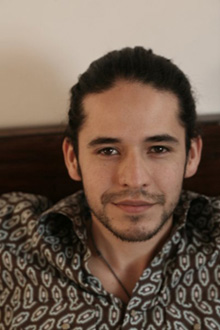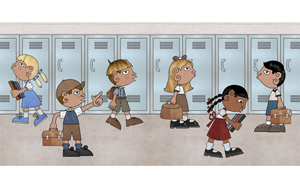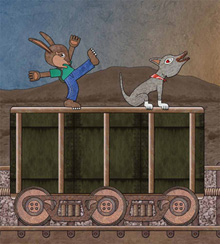 With his use of ancient artistic styles, Duncan Tonatiuh gives young readers a glimpse at classic Mexican style, while telling the stories of people who aren’t often given a voice. From Pancho Rabbit and the Coyote: A Migrant’s Tale to Separate is Never Equal, the author tackles tough subjects Hispanic immigrants face, taking on controversial topics like human trafficking.
With his use of ancient artistic styles, Duncan Tonatiuh gives young readers a glimpse at classic Mexican style, while telling the stories of people who aren’t often given a voice. From Pancho Rabbit and the Coyote: A Migrant’s Tale to Separate is Never Equal, the author tackles tough subjects Hispanic immigrants face, taking on controversial topics like human trafficking.
As a design major studying in New York City, Tonatiuh decided as a senior project to tell the story of one boy he met in the city. From that project blossomed an author’s career and a platform to talk about the issues facing Mexicans and Mexican Americans. Pancho Rabbit and the Coyote: A Migrant's Tale recently won the 2014 Tomás Rivera Mexican American children's book award and in addition to writing, Tonatiuh has given a TED talk about immigration and reaches out to students whenever he can.
Did you always want to be an author? A children’s book writer?
I loved to read when I was in elementary school and that made me want to write. In high school I became especially interested in writing fiction. That interest continued while I was in college. I never thought of being a children's book author, though, until the opportunity presented itself.
In college I studied writing but also illustration. A professor who one day came to critique our class's work really liked my drawings. She introduced me to a children's book editor at Abrams that she was friends with. The editor really liked my illustrations and told me that he wanted to work with me. He would contact me if he received a manuscript that suited my style.
I told him I liked to write too. He said, “great.” He gave me his e-mail and told me a few basic things about picture books, like the fact that they are usually 32 pages long or that it’s a good idea to have a child or an animal be the protagonist of the story so that young readers can identify with him.
A few months later while I was still in school I had an idea for a story. I wrote a manuscript. The manuscript changed significantly—my first draft rhymed and I am terrible at rhyming—but it eventually became my first book Dear Primo: A Letter to My Cousin.
I am very happy that I've become a picture book author and illustrator. I get two do to of my favorite things for a living: writing and drawing. And I get to talk about issues that I am passionate about in my books like social justice, art, and history.
Your illustrations are unique as homage to ancient pre-Columbian art. What draws you to that style?
 I grew up in Mexico and I was familiar with Pre-Columbian art from a young age. I saw images of it on text books or on codex-like crafts at the market. Growing up I did not pay much attention to it though. I was interested in drawing and art -comics and anime in elementary school, political cartoons in middle school, Egon Schiele and Van Gogh in high school- but not so much in Pre-Columbian images. It was not until my last year in college after I had lived in the US, away from Mexico, for almost ten years that I became interested in it.
I grew up in Mexico and I was familiar with Pre-Columbian art from a young age. I saw images of it on text books or on codex-like crafts at the market. Growing up I did not pay much attention to it though. I was interested in drawing and art -comics and anime in elementary school, political cartoons in middle school, Egon Schiele and Van Gogh in high school- but not so much in Pre-Columbian images. It was not until my last year in college after I had lived in the US, away from Mexico, for almost ten years that I became interested in it.
I was in school in New York City and I met a guy named Sergio at a worker's center where I sometimes volunteered. Sergio was an indigenous Mixtec from the south of Mexico. I sometimes heard him speak his Mixtec dialect with his relatives and friends. I was amazed that Sergio lived in a city in a foreign country, thousands of miles away from his home village, and yet he spoke his indigenous dialect and preserved many of his culture's traditions. I decided that for my senior thesis I would make a short graphic novel based on Sergio's story. I called it Journey of a Mixteco.
The first thing I did when I began the project was go to the library. I looked up Mixtec artwork and I found images of ancient Mixtex codex. I had seen images of Pre-Columbian codex before, but I was struck by them that day. I was fascinated with the flatness, the geometry and the repetition of color. I decided to make a modern day codex of Sergio's story.
I've continued to to draw in that codex-like style since. But I collage textures digitally into my illustrations. I use different types of paper, denim, hair, cloths, etc. Some things I scan, others I photograph or find in the internet. I like to create images that way. Hopefully they honor the past but are also relatable to kids nowadays.
In Pancho Rabbit and the Coyote, you address the serious and controversial subject of human coyotes who traffic migrants across the border through dangerous conditions. Why did you feel this was an important subject to address with a young audience?
According to a 2011 Pew Hispanic Center report there are an estimated 1.5 million undocumented children in the U.S and an estimated 5.5 million children of undocumented parent's in U.S. Schools. Pancho's story is the story of many of these children and of their families.
I think it is important for children to see themselves and their experiences reflected in the stories they read because it helps them know that their stories and voices are important. For the children that are not familiar with the experiences of Pancho the book hopefully creates empathy and lets them know about what other kids -some of whom may be in their classroom or school- have experienced.
The book deals with a difficult subject but I did my best to make a book that is appropriate for young readers. The characters in the story are animals which makes the story a little less shocking and terrifying. I have read the book with kids of different ages. Little kids who are four years old or even younger enjoy the story because it reminds them of a classic fable like Little Red Riding Hood or The Gingerbread Man. Older readers can understand and discuss the second layer of meaning in the story. Hopefully Pancho Rabbit and Coyote can be used as a way to discuss an important topic like immigration in classrooms, libraries and homes.
You interact a lot with your audience – you have the “Journeys: A Multivoice Poem” video posted on your website and you sent elementary students a questionnaire on winter to inform a mural you worked on for an Ohio museum – how does that interaction affect you and your writing?
 A Disclaimer: The Our Journeys multi-voice poem was created by the fourth graders of Metz Elementary and their teacher. I was not involved with it. They created that poem about their own immigration experiences after they read Pancho Rabbit and the Coyote. I was extremely moved when they shared the poem with me and I like to share it whenever I am able to because it is very powerful.
A Disclaimer: The Our Journeys multi-voice poem was created by the fourth graders of Metz Elementary and their teacher. I was not involved with it. They created that poem about their own immigration experiences after they read Pancho Rabbit and the Coyote. I was extremely moved when they shared the poem with me and I like to share it whenever I am able to because it is very powerful.
The mural I created for the Akron Art Museum was a wonderful opportunity and I wanted to involve kids from Akron in the process. I tried to use the kids’ words and ideas to create the mural. I really enjoyed that method of working and hopefully I will do more collaborative projects like that one in the future.
Writing and illustrating can be a very solitary endeavor. I spend a lot of time by myself in front of my desk when I am working on a book. It’s great when I get to visit schools, libraries or book festivals because I get to interact with kids. It’s very energizing and rewarding. I always try to pay attention to the way they dress, the way they speak and the things that interest them to hopefully make appealing books that they can see themselves reflected in.
We don’t often hear about the historical segregation or discrimination experienced by Hispanics, a story you share in Separate is Never Equal. How can we better include Hispanic history into the mainstream consciousness?
I think there are things we can all do. I think teachers, parents and librarians need to demand more books about Latino history so we can have them in schools, homes and libraries. Publishers need to be more courageous and publish more books about Latino history (a report by the Cooperative Children's Book Center at the University of Wisconsin-Madison found that only 3 percent of children's books are by or about Latinos). And authors and illustrators like myself need to make more books about this subject.
There are so many untold stories and there are so many different time periods in American History when Latinos played important roles—World War II or the Civil Rights Movement for example. Yet we barely hear any stories about Latinos during that time.
I am very grateful for the support Separate Is Never Equal has received. People that encounter the book appreciate it and want to use in their communities and classrooms. Kids are taken in by the story and can see a lot of parallels to their experiences. Although it is not legal to segregate children because of their ethnicity, language or background a great deal of segregation continues to exist today. According to a 2012 study by the Civil Rights Project at UCLA 43 percent of Latino students and 38 percent of black students attend schools where fewer than 10 percent of their classmates are white. I think it is important for all of us to take steps in the different ways we can to make sure we have books that deal with Latino history, social justice and diversity.
April Hall is the editor of Reading Today Online. She can be reached at ahall@/.